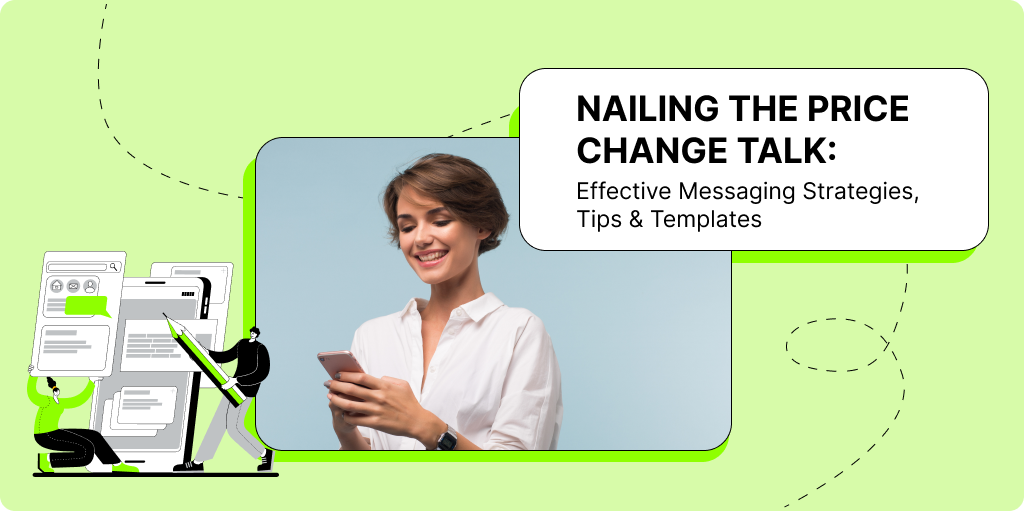 Nailing the Price Change Talk: Effective Messaging Strategies, Tips & Templates
Nailing the Price Change Talk: Effective Messaging Strategies, Tips & Templates
Learn how to effectively communicate price changes to your customers with our expert tips. Balance customer trust and loyalty while scaling your business!
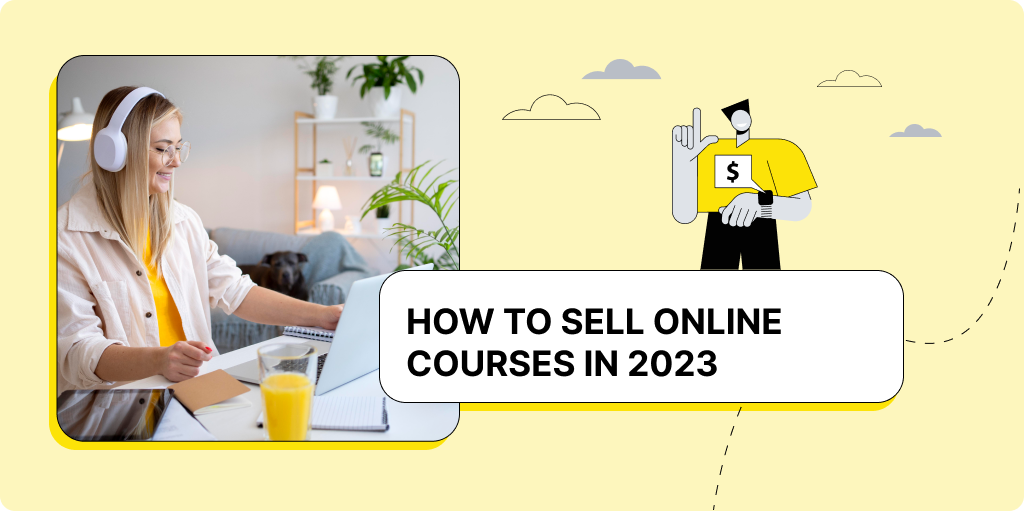
Why would anyone want to make an online course, and why, more importantly, should you make one? Nonetheless, the vast majority of business owners are open to the idea of offering online courses as a supplementary source of income. The production of online courses is less expensive, requires less time, and does not include any delivery charges; in exchange, you get a product that can be sold an endless number of times.
Businesses working with a wide variety of sectors have begun using a variety of training solutions, which helps the e-learning industry expand even further. The capacity to put money into education and continue one’s education throughout one’s life is a relatively new phenomenon that is gaining traction among people of all ages.
The tendency of people to prefer the comfort and flexibility of their homes, and avoid the complexities of commuting to physical classes, has led to their unquenchable thirst for personal development to explore new ways of developing their skills online. In addition, people tend to avoid the complexity of commuting to physical classes as much as possible.
At the same time, the most common motivation for an entrepreneur, or anybody else for that matter, to desire to build an online course is in order to establish a new source of passive income as an extra revenue stream.
Whether you have an idea, a talent, a passion, an audience, or any information you want others to view, develop an online course and earn money doing what you love. What you really have to do is to provide your students with an answer or a solution that serves a particular goal.
Learners will only come to you if they believe what you have to give is valuable and life-changing for their own personal or, more commonly, professional requirements. Your objective is to persuade them that your course is a chance for growth, a journey of change in which they are invited to participate.
Maybe the most critical phase in developing online courses is goal fulfillment. To do it properly, you must organize your course ahead of time and carefully choose the course topic and material.
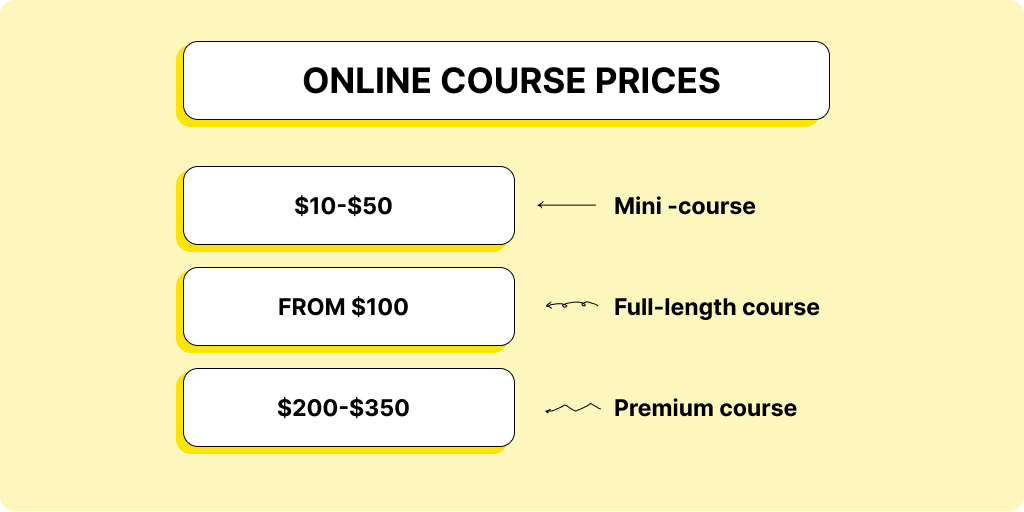
“How much should I charge for my online course?”. This is one of the most typical questions that every course designer has. Finding the sweet spot where your course pricing maximizes your income appears to be a difficult task! To do this, you must balance the worth of your course depending on quality, expectations, competition, and revenue targets.
For that reason, pricing your online course is critical. It conveys your worth, and it has an impact on the profitability of your course, your consumers, and the quality of your job. People may not buy from you if you price it too expensive. If you price it too cheap, you will not make a profit.
But, this varies according to the business, market sales, and the number of your own costs – both temporal and financial. In any case, bear the following in mind:
Your course is far more valuable than you realize. An online training course combines your job and personal experiences, as well as years of study and education.
Regardless of whether you are selling a genuine product or not, you are still giving a service and sharing your expertise, which is a highly valued commodity.
There are a few elements to consider in order to do this correctly
Consider your market’s level of credibility and authority. Have a look at the following.
If you aren’t yet regarded as an “expert” on your subject, offering free material is an excellent method to establish trust and authority in your industry. Do you have a blog, a YouTube channel, or a podcast? They are excellent methods for disseminating free material and establishing trust with your audience.
A sales page needs two elements: copy and design. To write the right content, you must first understand your audience, what they want, and how to persuade them. You must specifically address the three key questions concerning your course.
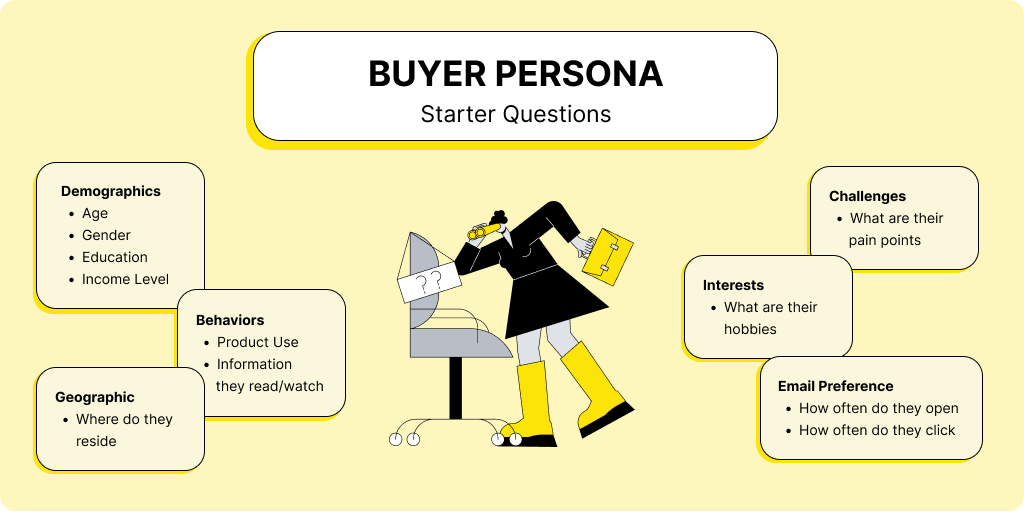
Defining your target audience is essential for producing successful copy and targeting the correct people who could be interested in your course. Answering this question can prompt you to consider your ‘Customer Persona,’ which may be a valuable tool in your marketing efforts. A customer profile is a set of features, demographics, attitudes, and behaviors that combine to form a fictitious “typical” persona for a subset of your target population.
Сonsider what type of solution you want to provide your consumers. The more information you provide about the solution, the better they will grasp the services you provide.
At this stage, it is critical to express precisely what type of outcomes your course may assist your audience in reaching. “By taking this course, you will learn how to arrange your space and manage your time better, and become more effective in your career and life while finding greater balance,” for example.
Your marketing pitch should make sense to your site visitors and explain why taking the specific course is essential. Make sure that everything on your sales page is relevant to your target audience, including topics of interest to your potential consumers (such as emails, blog posts, online courses, and more). This should assist you in listing all of the benefits that students may derive from your online course and incorporating these benefits into your content strategy plan.
While you are working on your sales page, you need to make sure that specific considerations are taken into account. This will ensure that no visitor will turn their back on your services; instead, they will remain on the page and continue to learn more about what your institution has to offer. Your goal is to catch their attention, and the best way to do so is by utilizing a context that has a specific level of clarity and equilibrium.
Along these same lines, the sales page for your online course should exude an air of trustworthiness as well as a feeling of continuity, which will encourage visitors to return again and again. Think about utilizing the items on the next page for a better end result.
A strong sales page should begin with a headline with extensive, bold writing that provides readers with a sense of what they will discover on your page. Using the course title alone will not be enough for a course sales page. A better method would be to briefly list the substantial benefits that the potential student may obtain by enrolling in the course.
A captivating title on your sales page is likely to pique the clients’ curiosity to learn more about your services. Your title should favorably predispose the reader based on their needs and desires, as well as promise them a fascinating outcome if they stay around and read what follows.
Visitors to your sales page must be engaged, interested, and enticed by your courses. At such times, action words and phrases that might increase their enthusiasm to study are your greatest allies.
Verbs and phrases that encourage action are most effective. Terms like “discover,” “emerge,” and “explore” will make them feel like they are a part of the e-learning experience you are providing, whereas words like “learn,” “do,” “improve,” and “start” will push them to take action.
The success of your marketing and sales activities will determine the level of profit your course generates. You will be required to make full use of all of the resources at your disposal in order to promote your course to the greatest extent feasible.
To put it another way, if you want people to buy your course, you’re going to have to put in some extra effort and get the word out there. Doing so is essential, but you will need to acquire the skills necessary to accomplish so in a logical manner. The sales funnel is a valuable tool for understanding the process of growing a customer base and bringing them closer to you. It comes into play at this point in the process.
Calling on your contacts and building your network starting from the people who are closer to you (such as family, friends, coworkers, business contacts/partners, affiliates, or students) is a powerful way to gather traffic. These people can talk about you to others, offer you referrals and product reviews, or conduct podcast interviews discussing what you do.
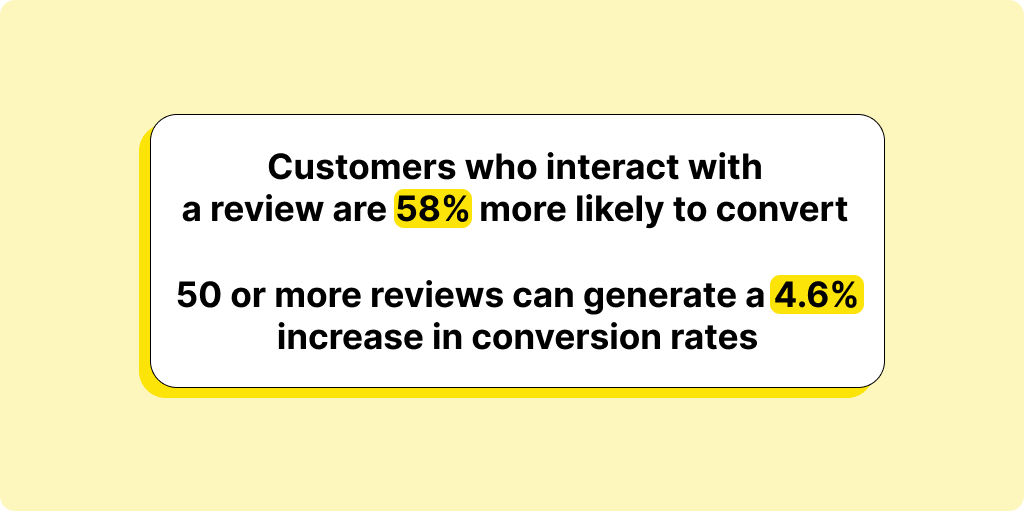
When you are selling a digital item, you need to give social proof that demonstrates that you are a reliable expert on the subject matter that you are selling. Your testimonials can originate from a wide variety of sources, including but not limited to emails, tweets, Instagram posts or comments, blog entries, and so on.
You should unquestionably include a client’s favorable feedback about your courses on the landing page of your website whenever that consumer provides it. Using the logos of prominent magazines in which your institution’s programs and/or courses have been featured may be a big boost to the credibility of your business.
Testimonials and quotations from satisfied students are effective marketing strategies that have a track record of being successful in the marketplace. These things may assist you in strengthening your personal brand and constructing your reputation in the realm of the internet. This is due to the fact that students are more likely to trust their fellow students.
Any kind of feedback review or testimonial may be helpful in positioning oneself as a legitimate entrepreneur, which should be your ultimate objective. This will demonstrate to the general public that you have something distinctive to offer in comparison to other people.
You must first generate course material that your audience will find helpful and valuable in order to draw more individuals into your sales funnel. This may be accomplished through organic traffic, such as a blog, a YouTube channel, or the creation of podcasts. Organic traffic and SEO are long-term strategies; while you can spend early, it will take months to enjoy the rewards. Your first priority should be to create excellent content, then use it throughout your funnel and make it SEO-friendly from the start.
You may also progressively expand your following list on social media, such as Facebook groups, Instagram, Pinterest, other groups or forums, or any different online location where you can readily engage with them. This is referred to as social media traffic.
You may also provide an incentive for prospective consumers to join your email list. Your aim is to establish trust with clients and construct an email sequence that will lead them to purchase your course. You may begin your email series by discussing the problem you’re tackling and then gradually present your course.
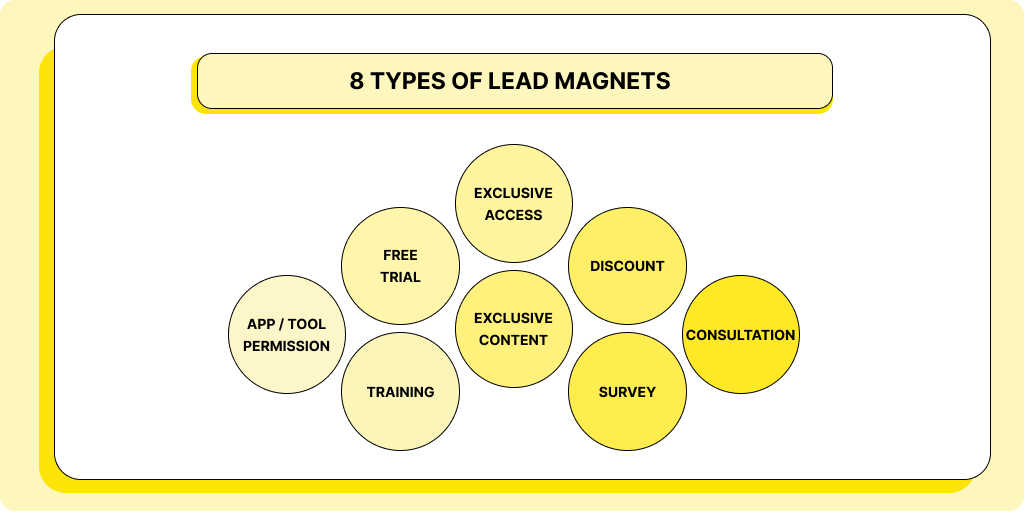
When a consumer visits your website, they may or may not be ready to make a purchase right away. Because of this, you will need a sales funnel that guides potential customers through the process in a methodical and sequential manner.
This funnel starts out with lead magnets at the very top. These are the “free gifts” (free material) that you will provide to your site visitors in return for their email addresses and are known as “freebies.” In its most basic form, a lead magnet is any piece of helpful information that can be processed in a short amount of time. It is also the initial stage in developing a sales funnel because it assists in the development of an email list.
It is crucial to keep in mind that the goal of a lead magnet is not only to collect email addresses. It needs to offer a solution to a problem, present information that is helpful, and exhibit your level of experience all at the same time.
If you are selling a course on Cooking Masterclass, for instance, you could want to develop a free course on “How to bake chocolate chip cookies.” This would be a great way to promote your paid course.
As compared to other marketing channels, the return on investment (ROI) for email marketing is four times higher than it is for any other medium. Email is the preferred method of contact for 2.6 billion people throughout the world, and the reason for this preference is that email is more direct, personalized, cost-effective, and transactional than any other form of communication.
Unique outcomes may sometimes be achieved by the utilization of email, particularly in an internet company. In order to begin utilizing email marketing, the first thing that you will want is an email list. It is simple to construct an email list in order to offer online courses. You may utilize all of the strategies that we have just outlined, particularly lead magnets, to build an emailing list and nurture the tips on that list until they become satisfied customers.
When it comes to email marketing, one thing you need to keep in mind is that the success of your campaign will depend more on the quality of the messages you send than the quantity. Your marketing strategies require considerable deliberation and deliberate development.
Sending out newsletters is one of the most efficient methods of using email for promoting your business. When it comes to newsletters, there are two things that can be said with absolute certainty: first, they are the most prevalent and most straightforward sort of email marketing to write, but second, they are also the most challenging to do right.
Blogging is important. It is no secret that owning a blog has several advantages. A blog, in addition to driving traffic to your website, may market your online school and courses in a manner that no other online tool can.
A blog increases brand authority by portraying you as an industry leader; it prepares your audience for product launches; supports your social media strategy; provides you with exciting material; and generates inbound links that aid your SEO efforts.
A blog also helps you build a loyal following of current visitors and clients, as well as attract new consumers who may be interested in what you have to offer. You can always use a reputable brand tracking tool to better understand your efforts and what your primary audience is looking for, allowing you to plan your approach more effectively.
Specific marketing strategies might help you move potential students closer to making a purchasing decision. Scarcity, countdowns/pre-launches, loss aversion, and other psychological techniques can work when combined with a good sales plan. You may use these tactics in your sales by using coupons, discounts, and course bundles or by changing your sales page to accommodate seasonal specials or reductions.
You may use coupons to share a variety of discounts and special offers at various percentages and prices. You may distribute the coupons to your email lists, submit them to multiple websites for offers/discounts, or post them on your social media pages/profiles or groups.
You may reduce the cost of your classes by offering discounts. This will allow you to accomplish the following:
It is not advisable to have cheap courses available all year. But, based on our experience, premium pricing is the ideal solution, with reductions serving solely as a marketing/sales tool.
When it comes to bundled offer to your audience one of the best ways is programs. While incorporating small group support, programs give a framework. Students will be required to conduct some work on their own asynchronously, following a template you will offer through a course. The advantage of this format is that a fantastic presentation may accommodate up to 20 persons without losing its personal touch. There are programs that can accommodate more than 100 pupils at once. Yet, keep in mind that you may miss the personal component that makes programs more exciting.
Any visual signals that guide site visitors to the CTA buttons and pictures on your sales page might guide them directly into your sales funnel. Visually appealing graphics, infographics, or any other type of compelling material that demonstrates insights into the outcomes of your online courses may have an enormous impact on your sales page.
Because images are absorbed faster in our minds than words, using media on your course’s sales page can help to strengthen your message. Graphic representations of the course’s value are compelling!
And don’t forget about the videos. A short (1 to 2-minute) film explaining who you are and what you do may complement your sales page well, providing an enormous impact. Any sort of video, such as an emotive plea, news/commentary, testimonial, or “behind the scenes,” might help by giving consumers a sneak peek inside your course and describing what your school/course is all about.
Internet users have the propensity to concentrate on the information that they see first on a website and skim the remainder of the content on any given page. Because of this, your best bet would be to highlight essential aspects of your training program and services at the very top of your landing page so that visitors can notice them as soon as the page loads.
You should also give some thought to including an “About Us” block on your sales page as an additional component of the page. This should ideally be a different kind of landing page that assists site visitors in gaining a better understanding of who you are and what you have to offer to the general audience.

Call-to-action buttons are worth every penny since they kick-start the sales funnel. As a result, they demand more attention. To acquire the correct call-to-action points, keep the following in mind:
CTAs are all about expressing your message in a way that motivates action, such as clicking on the “purchase button” (CTA). In principle, this seems more accessible than it is, in fact, but we have prepared several Call to Action samples and templates that are ready to use in your online school.
A solid sales page should be triggered by your CTA. But, a basic landing page with simply the CTA might also perform rather effectively. The easiest way to do this is to test what works for your target demographic. Don’t be hesitant to update your text after testing. This, coupled with producing marketing text for your course, may take some time. Your call-to-action may constantly be tweaked in the future to deliver higher conversions.
Is it financially rewarding to sell online courses? It most certainly is with those figures and the necessary knowledge. Once you have a customer base, selling online courses may be a source of passive revenue.
Your online course may also be used as a marketing tool to improve relationships with clients. Utilize your online course to demonstrate what your brand is all about. Show them what sets you apart from the competitors. Develop great relationships and observe how loyalty and advocacy for your course increase. The nicest part is that anyone can produce and sell an online course. All you need is some knowledge and the capacity to talk passionately about a subject.